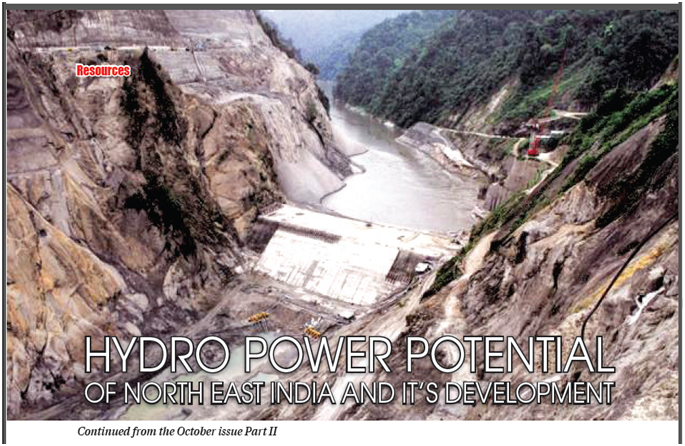
North East India: A Brief Profile
The North Eastern Region of India is recognised as one of the poor infrastructural development in comparison with other region of the country. As a result the region is lagging behind in the industrial and economic development scenario in comparison with other developed states of the country. But the region has a strong potential to be India’s future powerhouse. It has 42.54 per cent of hydropower potential of the country estimated at 63,257 MW, natural gas reserves of 190 billion cubic meters, coal reserves of over 900 million tones and oil reserves of over 500 million tonnes. Large mineral resources including limestone’s reserves of around 5000 million tones and a forest cover which is 25 per cent of the country’s forest area. Phenomenal biodiversity forest wealth particularly bamboo economy of north east India, agro base, fruits and vegetables and other horticultural products, enchanting hills, majestic rivers, fresh water lake, cave and beautiful islands which are potential for ecotourism and rural tourism, herbs, aromatic plants, exotic flowers and floriculture, other flora and fauna to be a future international trading hot spot towards more on South and South East Asian countries. Further, the present strategies of government of India’s Act East Policy will also led to expansion of more on trade, tourism and human relations between neighbouring countries of south East Asian countries.
If such inexhaustible sources of hydro power resources and other mineral and natural resources are exploited minimum at par with national level and maximum at par with global average of 30 per cent and above, it will make sure to accelerate the socio-economic development of this backward region of the country. There is thus, an immediate attention is required to develop and harness this huge power potential of the region, which not only reap the benefit for socio-economic development of the region but also for filling the gap of changing power scenario of the country in near future.
Hydro Power Potentials of North East India

The North Eastern Region of India is blessed with the highest hydro power potential far exceeding the region’s internal requirement for power. As per the report of the ranking studies conducted by Central Electricity Authority, government of India, there are 1,48,701MW hydro power potential spreading in 845 different schemes in the country. Of which 66,065 MW from 140 schemes have been identified as potential sites from North Eastern states contributing 44.43 per cent of total hydro power potential of the country.
Above given table shows the hydro power potential of North Eastern Region in state - wise. Arunachal Pradesh is having the highest potential of hydro power not only in the region but also among the states and union territories of the country. Next to Arunachal Pradesh, Sikkim state accounts the second highest ranking in potential of hydro power with a total potential of 4,286 MW. Next to Sikkim, Meghalaya, Mizoram, Manipur and Nagaland stood in third, fourth, fifth and six respectively. Assam though lowest in total hydro power potential but it has harnessed the maximum hydropower potentials in the region. Assam is having the highest thermal power resources also in the region. Likewise Tripura has also no potential of hydro power but it has an ample scope for thermal power resources in the region.
The North eastern power region has achieved only 3.02 per cent of its’ hydro potentiality up to October 2013, whereas national average is 23.53 per cent. Even after completion of different hydro schemes under construction, the potentiality will be achieved up to 4.84 per cent only. Among the eight states of the North East Arunachal Pradesh has the highest Hydro potentiality with 50,328 M.W that is 79.56 per cent of this region and 33.84 per cent of the country. Arunachal Pradesh itself could be the ‘Power House’ of India. As of October 2010, there were 132 memoranda of understanding (MOU) signed between the Government of Arunachal Pradesh and potential developers of hydropower projects with a total capacity of 40,140MW. 120 of those memoranda are with private companies. According to one estimate, in a ten year period, Arunachal Pradesh proposes to add hydro-power capacity which is only a little less than the total hydropower capacity added in the whole country in 70 years of independence. Sikkim stands second with 6.77 per cent and Meghalaya stands third with 3.78 per cent hydro potential among all states of the region.
Among all the North-Eastern states Assam has harnessed maximum hydro potentiality 55.14 per cent following Sikkim 15.6 per cent and Meghalaya 11.78 per cent. Arunachal Pradesh harnessed only 0.8 per cent of it’s’ potentiality. In term of projects under construction Arunachal ranks 1st and Sikkim is 2nd in this region. After the completion of these projects where Sikkim will achieve 69.77 per cent of hydro potential, Arunachal Pradesh will get only 6.18 per cent of its’ potentiality. Among the all North Eastern states Sikkim and Assam are in advance stage in term of achievement of hydro potential and others are enough lagging behind. Over all development of the region is not satisfactory at all, this region has harnessed only 3.02 per cent hydro potentiality, 8.12 per cent is in capacity building stage and rest 88.36 per cent yet to be harnessed.
Dr.A.Rajmani Singh
To read the further article please get your copy of Eastern Panorama March issue @http://www.magzter.com/IN/Hill-Publications/Eastern-Panorama/News/ or mail to contact @easternpanorama.in

